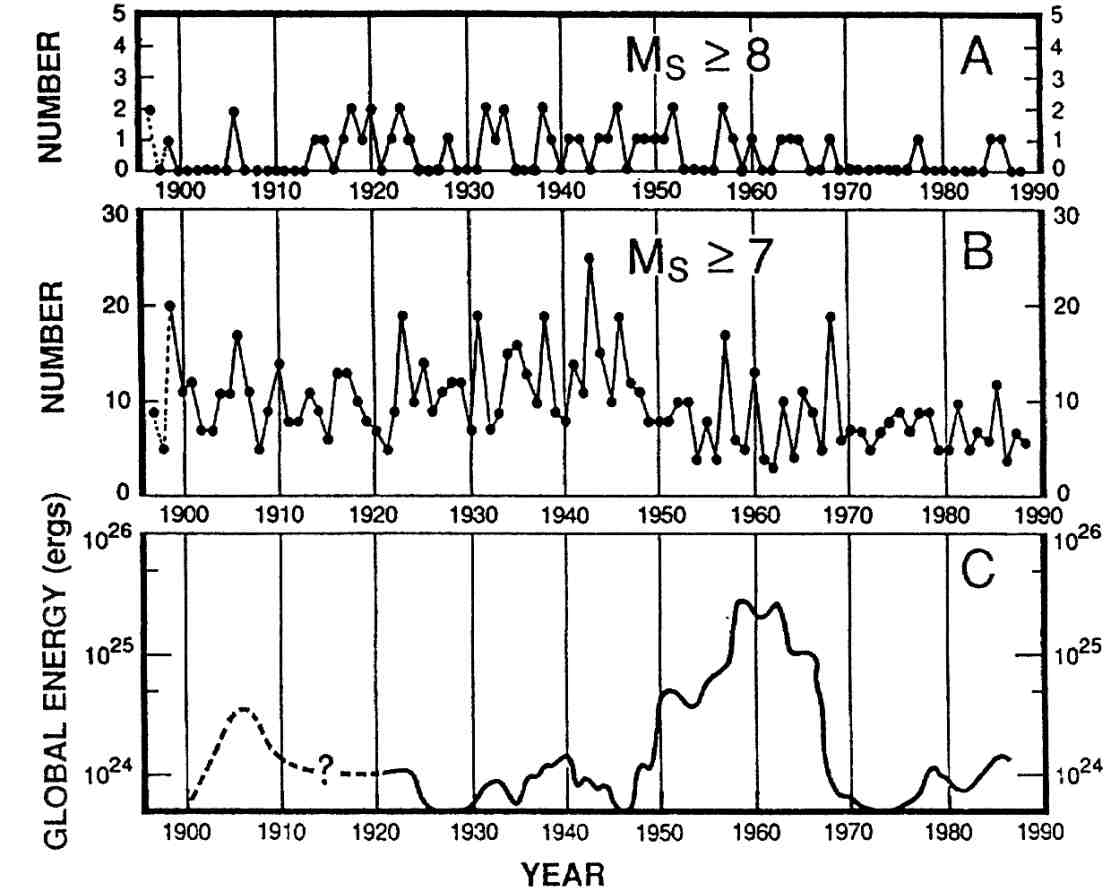Earthquakes are among the most awesome, and sometimes most terrifying, natural events a person can experience. That was brought to the world's attention again by the great California earthquake of October 17, 1989. Already, that earthquake is recognized to be the most costly natural disaster in the history of the United States. Christians, also, have been asking what God's purposes have been for earthquakes.
SPECIAL PURPOSES FOR ANCIENT EARTHQUAKES
A review of the twelve historic earthquakes of the Bible shows that they were used at various times for special purposes.
- Day Three of Creation Week. On the third day of creation the earth's waters were collected into their oceanic basins as continents appeared (Genesis 1:9,10). Continents were uplifted and the ocean floor was depressed during a great faulting process which "established" the foundations of the earth. We are told that angels saw and praised the omnipotent God as this earth-shaking process occurred (Job 38:4-7; Psalm 148:1-6; possibly Psalm 104:5,6).
- Noah's Flood on the Earth. One of the primary physical causes of God's great judgment in Noah's Flood was the splitting open of all the fountains of the great deep (Genesis 7:11). Enormous earth upheavals on the sea floor occurred as sea floor springs were faulted open, unleashing a universal flood on our planet. God's purpose was to begin the human race again from the family of Noah.
- Crossing the Red Sea. Although the historical record of Israel's crossing the Red Sea (Exodus 14) has no reference to earthquakes, the poetically heightened account in Psalm 77:18 speaks of God's voice expressed as earthquakes accompanying this extraordinary deliverance.
- Moses on Sinai. Before God spoke to Moses and gave the Ten Commandments, there was a great shaking of the mountain (Exodus 19:18). No doubt the earthquake prepared both Moses and Israel for the important truths the Lord was going to communicate.
- The Fall of Jericho. Bible readers, especially those who are familiar with the archaeological excavations at Jericho, have supposed that an earthquake toppled the walls of the city. However, the account of Israel's conquering the city of Jericho (Joshua 6) contains no reference to earthquakes. There is no doubt that the fall to earth of the city's great wall would have caused the earth to shake. God delivered the city, by whatever means, into Israel's hand.
- Korah's Rebellion in the Wilderness. Korah and all his men were killed, and all of their possessions taken, as the land on which they were camped split apart and closed back upon them (Numbers 6:31-33). The 250 men were destroyed by God because they were in rebellion against Him.
- Philistine Camp near Geba. Israel conquered the Philistines near Geba after an earthquake occurred in their camp (I Samuel 14:15). Jonathan and his armor bearer were separated from their army and would otherwise have been killed by the Philistines.
- Elijah on Mount Horeb. God spoke to Elijah at Mount Sinai (Horeb) as He did before to Moses after the occurrence of an earthquake (I Kings 19:11). Elijah, who had been hiding in a cave, realized that the Lord does not need to use a mighty earthquake to speak, but can, in His meekness, reveal Himself simply in a still, small voice.
- Uzziah's Earthquake at Jerusalem. Uzziah, the longest-reigning King of Judah, became proud of his great buildings and the strength of his army (11 Chronicles 26). The Lord afflicted Uzziah's kingdom and buildings with a great earthquake (Amos 1:1; Zechariah 14:5) as well as Uzziah personally, with incurable leprosy. A recent technical report gives evidence that this earthquake was the largest in the last 4,000 years of Palestine.1
- The Crucifixion in Jerusalem. When our Lord Jesus Christ died on the cross, a great earthquake tore the curtain of the sanctuary of the temple, and many dead saints were resurrected from their tombs (Matthew 27:51-54). The earthquake was used by the Lord to show the great salvation that had been accomplished that day on the cross. Because of the earthquake, the centurion and those with him at the cross recognized that Jesus was indeed the Son of God.
- The Resurrection in Jerusalem. No human agency rolled away the stone blocking the opening of our Lord's tomb (Matthew 28:2).
- The Prison at Philippi. An earthquake not only released Paul and Silas from the prison (Acts 16:26), but it authenticated their testimony. The jailer who witnessed the event recognized the Lord's hand and believed in the Lord Jesus Christ.
"BIRTH PANGS" AND RECENT EARTHQUAKES
Recent earthquakes should receive a different interpretation in the Christian's thinking. Jesus Christ spoke of them as "signs" of His coming again to earth. He said, "There will be earthquakes in divers places" (Matthew 24:7; Mark 13:8), a fact now verified by the global distribution of earthquakes recorded on seismographs. Furthermore, He said this sign is the "beginning of sorrows" (Matthew 24:8; Mark 13:8). The word translated "sorrows" in many English Bibles is the Greek work for "birth pangs." Just as we know that a woman is going to give birth to a child because of birth pangs, Jesus says we know that the intolerable anguish of God's judgment and the return of His Son is at hand.
The birth pang theme is also alluded to by the apostles Paul and John. Paul speaks in cosmic dimensions of all creation "groaning in travail" (Romans 8:22), awaiting the new birth of the world; John speaks of the sign of the pregnant woman (Revelation 12:2) and later describes the greatest earthquake since men have been upon the earth, when mountains and islands will be displaced (Revelation 16:18-20). This great future earthquake will be associated with the return of Christ to Jerusalem (Acts 1:9-12; Zechariah 14:1-11), and is described as inflicting severe topographic and geologic changes on a global scale.2
 |
Figure 1. Global summary of ninety years of seismograph records showing the frequency and energy of large shallow earthquakes.3 A. Number of great earthquakes with measured surface wave magnitudes greater than or equal to 8.0 reported each year since 1897. |
Some people have supposed that earthquake frequency and intensity have been increasing significantly in recent times, and that this is fulfilling prophecy. This is an illusion caused lately by more frequent detection of earthquakes (more seismographs with greater sensitivity). The illusion is also promoted by the fact that earthquakes inflict greater damage on today's larger, urbanized populations, and, therefore, make the news more often. Since good seismographs went into operation late in the 1890's, no steady trend suggesting increased frequency or intensity has been demonstrated.
The birth-pang notion of earthquakes is verified by seismographic data, which shows their erratic occurrence. Figure 1 summarizes global data on large earthquakes during the last ninety years. For the decades of the 1950's and 60's, twelve great earthquakes with magnitudes greater than or equal to 8.0 occurred (Figure 1A), but for the decades of the 1970's and 80's, only three have occurred. Similarly, shallow earthquakes, with magnitudes greater than or equal to 7.0 for the period 1899-1970, averaged ten events per year, but during the decades of the 1970's and 80's, they have averaged just seven events per year (Figure 1B). Perhaps the best illustration of the erratic trend in earthquake frequency and intensity is seen in the total energy of large earthquakes (Figure 1C). A pronounced peak in global earthquake energy release occurred from 1952 to 1965. For the year 1989, the global energy release may be one-tenth the yearly release of the early 60's. Global seismic activity is very non-uniform in time; it is like waiting for birth pangs. When will there be another global upturn in seismic activity?
CONCLUSION
Earthquakes have been used of God at special times, with special people, for special purposes. Like other miracles, Biblical earthquakes were employed infrequently when no other human or physical agency could inflict judgment on the wicked, redeem His righteous people from difficult situations, or gain man's attention so God's Word could be considered. In fact, these three purposes—judgment, deliverance, and communication —should form our basis for understanding earthquakes. In our fast-paced, man-centered, technology-based society of the late 20th century, God would have us pause and consider His sovereign nature and His coming program for the world.
REFERENCES
1. S.A. Austin, "The Extraordinary Middle East Earthquake of 750 B.C.," ICR unpublished technical report, August 1989, 18 pp.
2. H. M. Morris, The Revelation Record, (Wheaton: Tyndale House Publishers, 1983), p. 321.
3. Figures IA and 1B after K. Abe and S. Noguchi, "Revision of magnitudes of large shallow earthquakes, 1897-1912," Physics of Earth and Planetary Interiors, 33 (1983): pp. 1-11. Figure 1C after H. Kanamori, "Importance of Historical Seismograms for Geophysical Research," W. Lee, H. Meyers, and K. Shimazaki, eds., Historical Seismograms and Earthquakes of the World (New York: Academic Press, 1988), pp. 16-33. These figures were brought current from the year 1980 to the year 1988 by a computer search of the global earthquake data base of National Geophysical Data Center, Boulder, Colorado.
*Dr. Austin is Chairman of the Geology Department at ICR.






.jpg)









